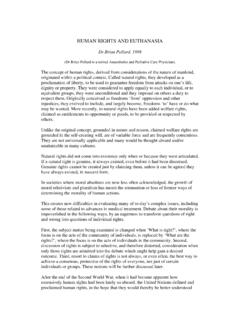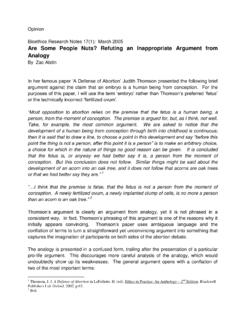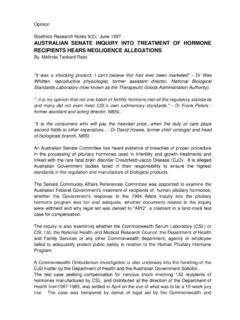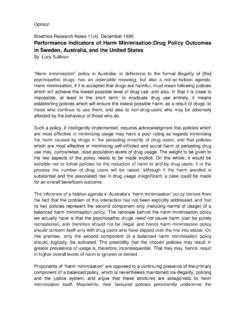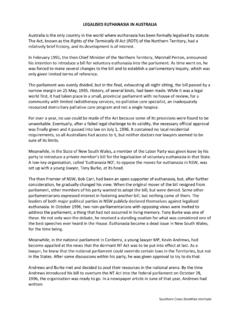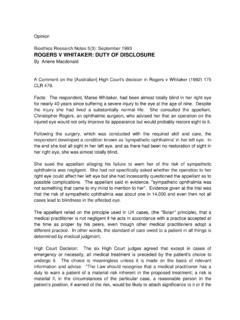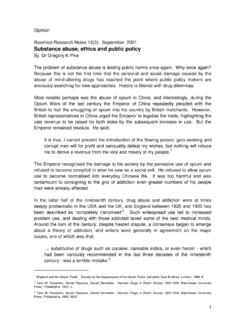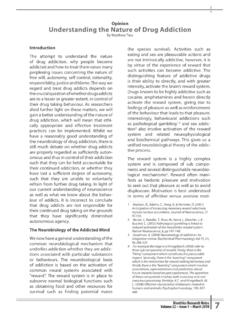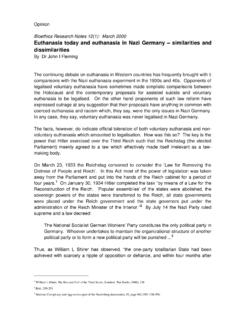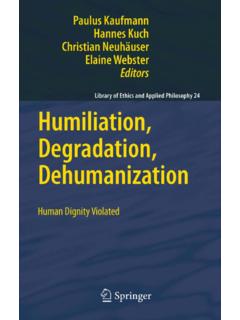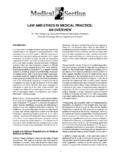Transcription of Ethics and Substance Abuse - Adelaide Centre for …
1 Ethics and Substance Abuse Dr Gregory K Pike, Deputy Director, Southern Cross bioethics Institute, Adelaide , Australia. Dr John I Fleming, Director, Southern Cross bioethics Institute, Adelaide , Australia. Jill Pearman, Drugwatch Australia, Sydney, Australia. Abstract Substance Abuse is a community concern that impacts modern societies across many levels. Not only are individual lives seriously adversely affected in terms of health and capacity for human flourishing, but familial and other relations are damaged and futures compromised. Primary prevention must take into account not only the reality of the successes or failures of public policies worldwide, but also the realities of human nature and fundamental shared human values. When foundational ethical issues are considered and clarified in relation to Substance Abuse , the most appropriate model(s) for public policy development are brought into sharper perspective.
2 The impact in Australia of the adoption of a particular public policy framework, harm minimisation, is discussed in relation to basic ethical principles. This paper is a collaborative work between the Southern Cross bioethics Institute in Adelaide , South Australia, and Drugwatch Australia in Sydney, Australia. I will first address some specific prevention issues for communities, making reference to the Australian situation, and then, consistent with the theme of this conference - Skills for Drug Abuse Prevention - address some of the core issues relating to the Abuse of mind-altering substances by considering some of the philosophical and ethical concepts central to drug Abuse . Virtually no community remains unaffected by Substance Abuse , and since drug Abuse impacts communities at all levels and in all sections in one way or another, active involvement by those same levels and sections of the community in reducing demand is essential.
3 And for prevention to be effective, a concerted effort that is broadly upheld with wide community support is necessary. Furthermore - and this is considerably more difficult to bring about - effective prevention requires social change with attention to fundamental human values and belief systems. A cohesive and successful drug policy should have as its primary objective the prevention of drug use, or at the very least, reduction of existing use. For genuine demand reduction, each individual needs to be armed with the knowledge, skills and an appropriate framework to reject Substance Abuse . Accurate scientific and medical 1information is essential. But perhaps more important is the sense that those in authoritative positions are consistent in the message they convey, and that they are truthful and free from ideological persuasion. Pulling in the same direction is crucial, for nothing confuses the vulnerable young more than their leaders holding and professing diametrically opposed positions.
4 A consistent position needs to be promoted by parents, families, police, media, business, sporting clubs, the judiciary, religious institutions, politicians, schools and other major institutions. At an international level, agreement has been reached on demand reduction. At the United Nations General Assembly Special Session in New York in 1998, all member countries signed a declaration to reduce drug use rates in their countries by the years 2003 and 2008. This was a historic agreement as it demonstrated that leaders of the world community were pulling in the same direction, at least with respect to demand reduction. However, in some communities agreement on common goals can be difficult to obtain. And in still others a climate of tolerance towards drug Abuse has already developed. In some communities, such a change as has occurred over the past 20 or so years has gradually shifted the perspective so that many people now consider drug Abuse as a normal, even though undesired, part of modern societies.
5 And normalisation is difficult to reverse. Once normalisation becomes ingrained in the public consciousness it can take considerable time to recognise the considerable damage such a new status quo brings before acting to regain control. In Australia in 1985, a change in drug policy occurred. Harm reduction or harm minimisation was formally adopted as the national policy to manage Substance Abuse . Concurrent with this, concerted prevention strategies fell by the wayside and the public perception of health and other risks arising from drug Abuse became trivialised. Statistics from the Australian National Household Survey demonstrate steady and disturbing increases in drug use across the population and particularly among young people. For example, the proportion of teenagers recently using heroin increased from in 1995 to 1% in 1998. The proportion of teenagers recently using marijuana increased from 20% in 1995 to 35% in 1998, and the largest increase was for adolescent girls.
6 If we were to make a comparison between Australia and the United States for example, where prevention has been a lead policy and community coalitions have been active, we would find that the percentage of people in the US who used an illicit drug in 1998 was less than 5% (1998 National Household Survey, SAMSHA), whereas in Australia in 1999 the figure was 22% (National Household Survey 1999, AIHW). Furthermore, Annual Household Surveys for the two countries in 1998 reveal that recent marijuana use in the United States for 12-17 year olds was compared with 38% in Australia for 14-19 year olds. 2 Another country with which relevant comparisons can be made is Sweden, particularly with its strong emphasis on prevention. Some comparisons between Australia and Sweden taken from the United Nations World Drug Report 1997 reveal the following: Lifetime prevalence of drug use in 16-29 year olds in Sweden was 9% compared with 52% in Australian 14-25 year olds.
7 Use in the previous year for the same age groups was 2% in Sweden compared with 33% in Australia. Estimated heroin dependent users per million population was 500 in Sweden compared with between 5000 and 16,000 in Australia. This translates to a percentage of dependent users in Sweden of compared with in Australia. It is therefore possible for differences in policy to have a very significant impact on basic indicators of the extent of the Substance Abuse problem. There are several strategies that can be applied in primary prevention that have been shown to be effective. First, increasing knowledge, raising awareness of drug effects and symptoms of use, and availability of resources. Second, building life skills and competencies of youth, parents, families and other community members. These skills include drug refusal, coping, communication, decision-making, and conflict resolution. Third, increasing involvement in drug free healthy alternatives.
8 And fourth, increasing access to prevention services, coupled with early identification and referral for individuals already experiencing Substance Abuse problems. But even more basic to the problem of Substance Abuse is a framework of understanding based on fundamental shared human values, upon ethical principles and a philosophical underpinning, and indeed upon belief systems, and what may be called a worldview. At a time when the underlying value systems and principles that inform the framing of the pertinent drug laws are being reconsidered by some elites, it is worth being reminded of the meaning of laws. The moral philosopher Germain Grisez notes: .. law s effectiveness depends far more on forming the majority s practical reasoning and judgements than on forcing the unwilling minority to 1 Germain Grisez, Should the city council vote to supply needles to drug addicts?
9 In: The Way of the Lord Jesus. Vol. 3 Difficult Moral Questions, Franciscan Press, Quincy University, Illinois, 1997, 830. 3 Laws have educative value far beyond their ability to rein in lawbreakers. They reflect deeply held values commonly shared across the community and serve to instruct all and sundry regardless of whether ultimately they are transgressed. The Australian Prime Minister is right to be concerned that heroin trials, recently proposed in Australia for example, will send the wrong message , for the principal part of the message that the requisite legal change would signify, particularly when interpreted by youth, would be that the state considers maintaining addiction to be a valid way of treating addiction. And young people are smart enough to read between the lines and see that this really means that the powers that be would consider addiction per se not to be a problem. A corollary might be that addicts are not worth the hard work of really helping them with what they truly want, that is, to no longer be enslaved to heroin.
10 The reality of addiction is captured in the words of Jason van den Boogert: .. there is no doubt that heroin has got a fierce hold of me and (the by-now tattered remains of) my life, and shows little sign of letting go permanently, , I don t know what will get this creeping rot out of my life for good. I have been clean many times but I feel that addiction has almost altered the chemical balance of my brain and from here on out life, clean or not, is going to be lived in relation to that thrown In the extreme tunnel vision that is addiction, life is bondage. And treatments that serve to perpetuate that addiction are state-sponsored assistance to self-destruction. The root of the word addiction can be found in the Latin addicere, which means to enslave. To be addicted is to be enslaved to something inherently harmful, not only because of its detrimental effects upon the body, but primarily because the influence upon the mind serves to damage that which is truly defining about being human that is the uniquely human capacity to think and reason.
